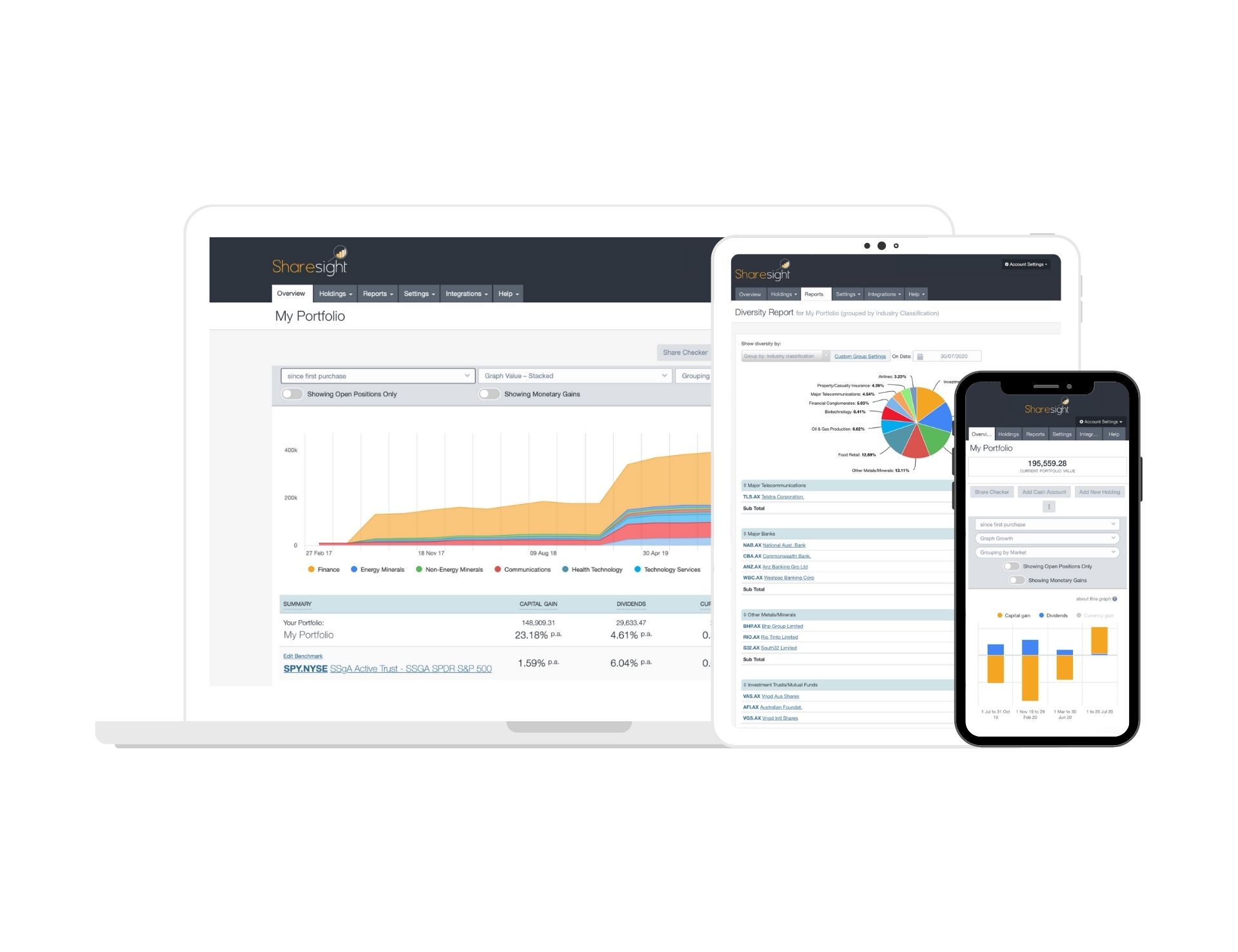What is diversification in investing?
When building an investment portfolio, there are many choices an investor will face – one of them being whether to focus on diversification or concentration. Diversification is often recommended to beginner investors or those who are looking for more stable returns, particularly when markets become volatile. Keep reading to learn more about the benefits and risks of diversification, different diversification strategies and how you can track your portfolio’s diversification with Sharesight.

What is diversification in investing?
Diversification is a strategy that minimises the risk to your portfolio by investing in a range of assets across diverse industries, fund managers, and product issuers. A good investment portfolio diversification strategy will ensure you receive stable returns from your investment portfolio.
Different assets and asset classes will do well at different times and in theory, as one industry or market sector dips, other investments will be doing well, balancing one another out. Implementing a strong diversification strategy can therefore yield higher returns and offer lower risk when compared to an investment portfolio made up of a singular asset or asset class.
Why is diversification important to have in an investment portfolio?
While a single high-risk asset may offer the potential of a huge payoff, it also comes with the potential for you to lose your entire investment in one go should it not succeed. Diversification mitigates the risk of pinning all your hopes, and money, on one single investment.
In a diversified portfolio, investment isn’t too heavily weighted towards one sector or company. That means even if certain events negatively impact the performance of some of your assets (e.g. drought affects agricultural shares), other areas of your portfolio will be unaffected.
How does diversification help reduce risk in investing?
Investing in a variety of different assets from different industries and sectors dilutes the risk associated with your investments. For this reason, a well-balanced investment portfolio, while not infallible, offers more stable returns in the long run. When your investment is spread across a variety of assets, countries and industries, market fluctuations have less ability to impact your portfolio.
Benefits of a diversification strategy
Often referred to as "the only free lunch", the key benefits of a diversification strategy include:
Increased exposure to opportunity
A diversified portfolio increases your chance of exposure to investments that are leaders in their sectors or markets.
Mitigating risk
When you spread your investment across a range of industries, countries, and asset classes with low correlation, the chance for dramatic events to severely impact your entire portfolio is minimised. While a diversified portfolio cannot mitigate overall market risk, it does help avoid risks specific to particular companies or sectors.
Protecting your investment
Often it's important for investors to have a stable portfolio when they are no longer in the wealth accumulation phase of their investments and are now hoping to protect what they already have. In this regard, diversification can help with the preservation of capital, protecting your savings, and offering stable returns.
Risk of a diversification strategy
While diversification can be a boon for investors, it doesn’t come without risks. Risks of diversification strategies include:
Diversification can be overcomplicated
The complexity of a diversified portfolio can be a barrier to diversification. More assets and asset classes don’t necessarily mean better and ideally, a well-diversified portfolio will be simple enough that you can stay on top of the investments you’ve made and have a solid understanding of each one.
Over diversification can lead to below-average returns
Over diversification can mean the quality and success of your portfolio suffer. If you have 30 underperforming stocks for example, and only five successful stocks, your returns will become diluted.
Higher transaction costs
The more broadly diversified your portfolio, the more you will have to pay in transaction fees or high mutual fund fees if you hold too many investments in one portfolio.
What are the types of investment diversification?
There are five styles of diversification across the spectrum of investment:
Diversification across companies
Diversifying your portfolio across a range of companies from ETFs, LICS, managed funds, or even a crypto ETF, gives access to an incredibly broad variety of companies that aren’t closely correlated and makes for a more stable, diversified portfolio.
Diversification across industries
As important as it is to not simply invest in one company, it is also advantageous to invest across industries. Investing in a range of industries and sectors ensures single events or "specific risks" are less likely to impact your portfolio’s success.
Diversification across asset classes
Asset classes include everything from shares, bonds, deposits and real estate to cryptocurrency. It’s important to understand the performance and underlying components of your different investments and to not over diversify.
Diversification across geographies
While it may seem there is a correlation across global markets, investing in multiple markets in multiple countries can be hugely beneficial to your portfolio.
Diversification through time
Buying parcels of investments over time (e.g. purchasing small amounts of the same shares quarterly or annually) can help mitigate concerns around market fluctuations and can average out the cost of bad timing.
Different types of diversification strategies
The asset allocation in a well-diversified portfolio is more important than the individual stocks it holds. In a solid investment portfolio, you can have a good mix of stocks and mutual funds (or "equities"), bonds, and cash. When considering what balance you want to strike between these different asset classes you need to consider the risk and reward offered by each asset and whether you want to invest more in higher-risk options or more stable, steady choices.
An example of a well-diversified portfolio is the Swenson Model by David Swenson, who managed Yale’s endowment from 1985 to 2021. Swenson’s portfolio is comprised of:
-
Domestic equities (30%)
-
Real estate funds (20%)
-
Government bonds (15%)
-
Developed world international equities (15%)
-
Treasury inflation-protected securities (15%)
-
Emerging market equities (5%).
What makes this a successful portfolio is that no one asset makes up a large portion of the investment, allowing it to offer reduced risk while maintaining a solid return.
How do you track investment diversification?
Tracking investment diversification can be tricky, as by its very nature having a diversified portfolio involves a lot of moving parts. It’s possible with a spreadsheet, but time-consuming.
Sharesight’s investment diversification tracking tool, however, allows investors to see their portfolio performance and the diversity of their holdings at a glance. The Diversity Report function delivers reports based on one of six criteria:
-
Market
-
Sector classification
-
Industry classification
-
Investment type
-
Country
-
No grouping
Asset allocations outside these default groups are also available to users, as well as a Custom Groups option.
Track your diversification (and your performance) with Sharesight
Thousands of investors like you are already using Sharesight to manage their investment portfolios. What are you waiting for? Sign up and:
-
Track all of your investments in one place, including stocks, mutual/managed funds, property and even cryptocurrency
-
Automatically track your dividend and distribution income from stocks, ETFs and mutual/managed funds
-
Run powerful reports built for investors, including Performance, Portfolio Diversity, Contribution Analysis, Future Income and Multi-Currency Valuation
-
See the true picture of your investment performance, including the impact of brokerage fees, dividends, and capital gains with Sharesight’s annualised performance calculation methodology
Sign up for a FREE Sharesight account and get started tracking your investment performance (and tax) today.

FURTHER READING

Morningstar analyses Australian investors' top trades of FY25
In this article, Morningstar reviews the key events of FY25 and shares three stocks their analysts are watching closely.

Key takeaways from SIAA 2025: Trends, insights & industry highlights
We summarise the key takeaways from the 2025 SIAA conference in Sydney, covering industry insights, market trends and the future of financial advice.

5 ways Sharesight keeps your data safe
Here at Sharesight, we maintain constant vigilance around cyber security. In this blog, we discuss five ways Sharesight keeps your data safe.